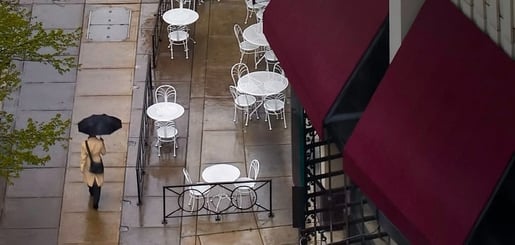
In almost all cases, it’s extremely important for canopies to be waterproof. Even if your area doesn’t get a lot of rain, the canopy needs to protect people from rain and to not be affected by rain in other negative ways when it does occur. If you were under the impression you had bought a waterproof canopy but it’s now starting to leak or show signs of water damage, you may have bought a canopy that was simply water resistant or made waterproof in a short-term way.
The difference is mostly in the type of fabric used, but there are ways to tell the difference even if you don’t know what fabric your canopy is made of.
Water Damage
There are different types of damage your canopy may encounter, so just the presence of damage doesn’t automatically mean it’s not waterproof. Of course, if the canopy is just straight up leaking, which usually occurs at the seams, it clearly isn’t waterproof. Some signs are more subtle. If mildew starts to build up or you can reach up and feel that the underside of the fabric is wet during a rainstorm, that is definitely a good indicator that the canopy isn’t waterproof.
There are many ways your canopy can be damaged that aren’t related to the waterproof factor. Sun can cause damage and fading if the canopy fabric isn’t sun resistant, and heat can cause the fabric to warp. Some canopies are made of fabrics that are harder to clean, which can unfortunately cause them to become irreparably dirty somewhat quickly.
Levels of Resistance
Water resistant canopies will repel water on a very low level. Think of your phone -- if it or its case is water resistant, you don’t have to be super worried about taking it out if it’s drizzling, but you wouldn’t use it near the pool or in a downpour. Water resistant canopies can withstand a bit of moisture -- morning dew isn’t going to cause damage to these in the short term, but extended or heavier rain definitely will.
Then there are canopies made of non-waterproof fabrics that have been coated with waterproof materials. These are often advertised as waterproof but they really shouldn’t be because they aren’t truly waterproof. This coating will last for a bit, but not as long as your canopy should last, and once the waterproof coating has worn off, there is nothing to protect your canopy from the elements, so it can go downhill very quickly.
Material Difference
What it really comes down to is the fabric itself. Some fabrics are waterproof and some aren’t, and really, the difference is in whether a fabric was manufactured to be waterproof. Natural fabrics simply aren’t waterproof. Even with waterproof coatings, the best you can get on a natural fabric like cotton is water resistance. Some synthetic fabrics are able to be waterproofed more effectively for a short time. These include fabrics like acrylic and polyester. The coating applied to these stays on for a bit, but will wear off with time and expose your canopy to more and more water damage as it wears off.
The only truly waterproof fabrics are vinyl-based polyester composite synthetic fibers. These fabrics are inherently waterproof because they were designed that way. The seams have a lot to do with it. Other fabrics have to be joined by sewn seams, which create points of weakness and places for water to leak through. With vinyl-based polyester composite fabrics like Herculite’s, the seams are able to be dielectrically heat sealed, which makes them impenetrable by water. This gives you a truly waterproof canopy you really can’t get from another type of fabric.
Thinking about buying a new awning or canopy? Download our “Five Factors to Consider When Determining Awning Fabric Quality” Guide before making your new purchase.
